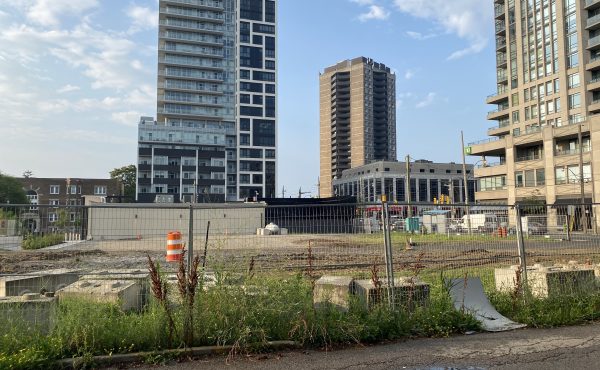The City of Toronto is embarking on a Heritage District study for Queen Street West between University and Bathurst. The study will create an inventory of buildings along Queen, identify key buildings of historical interest, seek to identify the essential character of the street, and provide specific recommendations both for preserving existing heritage buildings and shaping the construction of new developments in order to maintain this character. It is the first heritage district study of a commercial area in Toronto — the others so far have been residential areas (although commerical areas have been designated heritage districts in other cities in Ontario, such as Stratford).
The study is being conducted by the Office for Urbanism consulting group, and they gave a most interesting presentation of the project at Citytv studios tonight (October 25, 2005) to launch the project. There will be further public meetings in the winter and the spring as the report is developed and finalized.
The study is being paid for by “guilt money” extracted from Canada Life by local residents in compensation for the utterly out-of-character and out-of-scale office tower the company built at Queen West and Simcoe, just west of University. As a local resident put it at the meeting, the idea was to get them to pay to make sure that no-one else would be able to do the same thing they did.
Local residents and business owners made several interesting points, including the fact that it is important to keep bars, restaurants and music venues in the area, since they keep life going on the street in the evening, whereas retail outlets close at 6 and become dead afterwards. Also emphasized was the importance of sunshine, even in the winter, for keeping the street lively. One of the consultants noted that they had discussed including sunlight as a heritage feature — the audience strongly encouraged them to consider this innovative idea seriously.
Several contributors also emphasized the importance of narrow store frontages along Queen as being essential to its character. Not only do they break up the vista, making an interesting and varied streetscape that attracts pedestrians, but they also ensure that the storefronts remain reasonably affordable, providing a space for independent store owners and entrepreneurs to open creative new businesses — which is what made the strip such a destination. The consultants were urged to incorporate narrow storefronts as a key aspect of Queen West’s heritage character.
Unfortunately, rumour has it that they may already be too late. The vacant lot at Queen and Portland has apparently been bought by Loblaws, who (it is rumoured) plan to create a super-store that would be entirely out of character, and would kill existing local businesses. Several other blocks of heritage (but not currently protected) commercial buildings are said to have been purchased by chain retailers, who apparently plan to demolish them and install single big-box stores in their place. (Another concern is that these stores, unlike the old buildings, have no residential spaces, because they have no upper storeys, thus losing the mixed-use character of the street that helps make it so vital and varied).
The irony is that the unique character of Queen West might be identified just in time for it to be lost.



